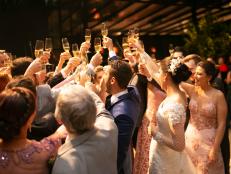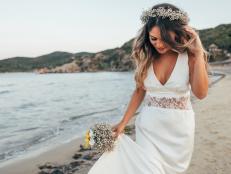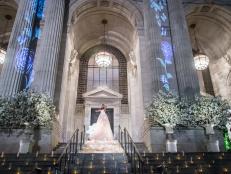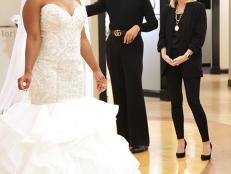20 Traditional Wedding Dress Styles Around the World
Cultures as beautiful as the bride.

Brides From Near and Far
Something old, something new, something borrowed, something blue, and a white dress to round out the American tradition upheld every year at weddings across the country. Though many women in the United States fantasize over white tulle and detailed veils, others around the world spend hours satiating a desire for color, elaborate stitching, headpieces and beading. These 20 traditional wedding dresses complement the beauty in each custom, and the bride who wears them.
Pakistan
Pakistani women are visions in their veil, wide-legged pants and gharara – a brightly colored tunic. Brides can often be seen in gold, yellow, purple, pink or red, with jeweled accents from the veil twinkling in their hair.
Malaysia
Malay brides wear a crown on their wedding day, illustrating their importance in the sacred ceremony. Under it are two layers – a tudung, or a hijab, to cover her hair for modesty and a selendang, which is a decorative shawl that covers her headscarf. In an equally dazzling display, a bold sarong compliments her long-sleeved blouse.
Nigeria
There are several ethnic groups in Nigeria and each has its own special wedding day traditions, but one of the most recognizable belongs to the Yoruba, whose brides wear carefully woven cloth referred to as Aso Oke. The material is regarded highly and meant to demonstrate high-class taste. The bride’s attire often consists of five pieces, including a lacy, long-sleeved blouse, waistwrap, shawl or sash, scarf and veil.
Philippines
Located in the southern Philippines, Yakan women wear wedding dresses with heavy but vibrant fabrics. Geometric shapes are weaved into her dress, bottoms and matching headscarf. A bamboo and flour mixture is used to draw diamonds and circles on the couple's faces.
Korea
Korean brides wear a hanbok – the traditional dress style dating back thousands of years in history. Hanboks are customized for special occasions like weddings and brides often wear them in shades of pink or purple for the ceremony.
Mongolia
Both the bride and groom don traditional clothes known as Del. In Mongolia, the groom’s is a darker color while the bride stuns in brighter shades. The fabric choices are often lightweight, and have a beautiful balance of silk and cotton.
India
Indian weddings are known for their vibrant colors and those represented in the bride's dress hold great meaning. Common colors include red, yellow and green, which respectfully symbolize power and strength, prosperity and wealth, and a new birth.
Japan
Religions across Japan boast different wedding traditions. During one of the country’s most popular nuptial styles, known as a Shinto wedding, the bride wears a white shiromuku as pictured above. Similar to the west, white represents pureness and virginity, but differs as the color simultaneously represents a woman’s willingness to come into the marriage “blank” and open to her husband’s values.
Peru
Many weddings in Peru adopt the classic white dress style, but those in the countryside continue to uphold older traditions. Peruvian weddings are filled with color and the bride’s look is no different, consisting of geometric shapes outlined in red, yellow, blue, green, white and so on. A specially made, layered skirt will be prepared for the day and is designed to correspond with her husband’s custom poncho.
Indonesia
Indonesia is home to many different ethnic groups but its largest, represented by over half of the population, is the Javanese. Their weddings consist of three parts: Siraman, midoreni and the wedding ceremony. During the first, the bride is bathed in scented water by her family. On the second day, she must remain inside during the evening and receive friends and family before the third day, when she dresses in an elaborate batik cloth that overlays a decorative blouse and wraps around her waist.
Ghana
Gold, gold and more gold. Ghanaian brides are often dripping in hints of yellow and gold, most of which are found in the traditional kente cloth their dresses are made from. Originally meant for kings, kente later adapted into being used for special occasions, like weddings.
Poland
Women in Poland follow the white gown trend and pair their dress with a veil known as a welon. Brides avoid open-toed shoes because superstitions dictate that their future wealth may fly from their toes if not enclosed.
Afghanistan
Religious couples in Afghanistan uphold tradition by engaging in a nikah ceremony, where the bride and groom are taken to different rooms and asked if they accept the other as their husband or wife. Once both accept the marriage, the bride and groom are pronounced as husband and wife.
Yemen
Traditional Yemeni weddings last five days! On the first, brides wear a face cover as they receives guests who bring roses and lay them before her. Similar to the Javanese, women in Yemen are then bathed. The bride's hands and legs are decorated with henna on the third day, and her body is similarly fashioned in jewels and gold for the fourth. The fifth day is devoted to the wedding itself.
Tibet
Betrothed women in Tibet who take part in traditional ceremonies wear a layered, white dress made of wool with colorful aprons on top. Some may swap the apron for an equally vibrant robe.
China
While western cultures often associate red with devious behavior, the opposite is true in China where the color signifies happiness, life and a deterrent of evil. With the addition of gold accents, Chinese wedding dresses often flaunt bold shades of red. In the north, most brides wear a red frock known as a Qipao, while southern brides wear two-piece Qungua.
Kenya
Kikuyu people belong to an ethnic group in Kenya. For their weddings, the bride and groom wear brown tones that are highlighted by beads. More modern brides opt for a stylish and colorful Ankara print.
Norway
Weddings in Norway often resemble those you would attend in the U.S. or parts of Europe. Many brides wear a white gown, but there remain those who uphold the Norweigan bunad. The bunad is a traditional dress often designed with buckles, jewelry and floral imagery.
Guatemala
In Guatemala, the veil steals the show. It is believed that the longer a bride’s veil, the happier she and her husband will be throughout their marriage, and because of this, veils can be well over six feet long. Instead of a dress, women wear a Patzun Huipil – a traditional blouse often embroidered with flowers – and a similarly designed skirt.
Scotland
When many think of Scotland, criss-crossing bands of green, red and yellow springs to mind. The traditional Scottish weaving pattern, known as tartan, has been upheld at weddings despite many brides adopting western styles. While a white wedding dress is customary, Scottish women add a tartan cape, train, bow or waistband to tie in their heritage.




















